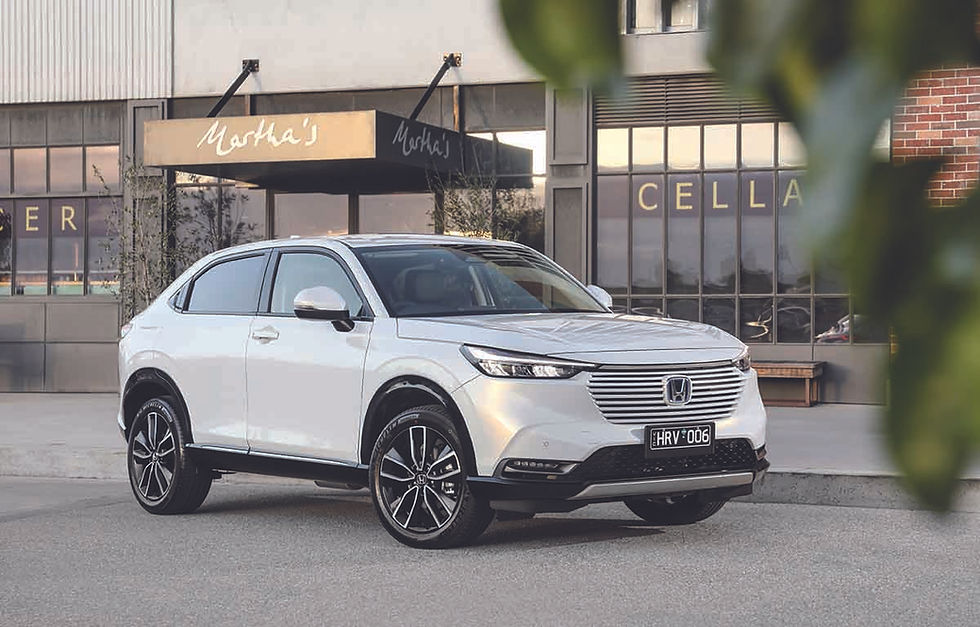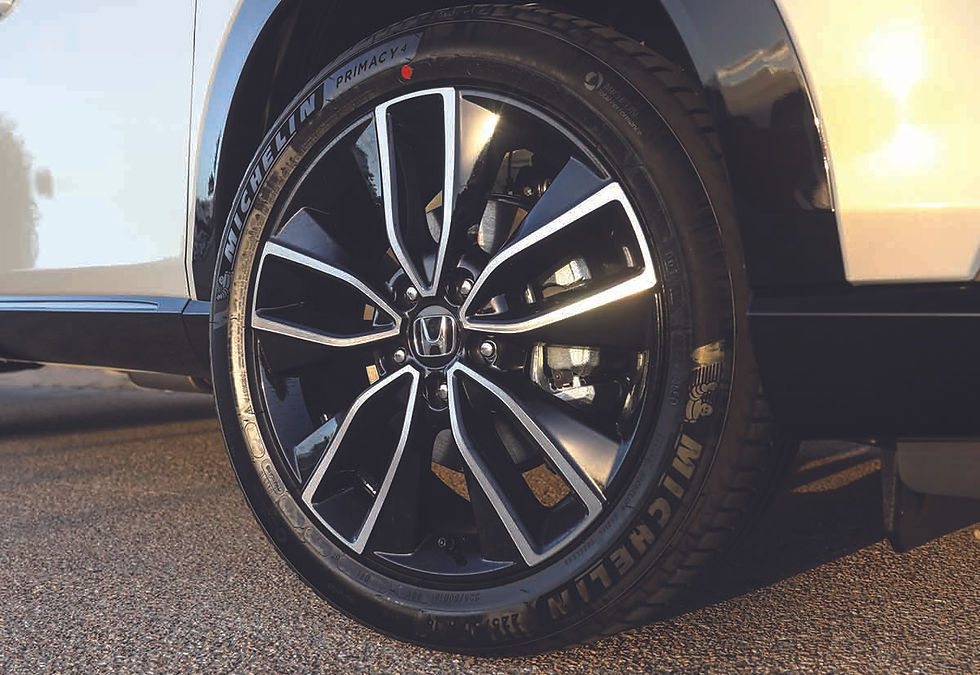
SHOWING it is not just Australia that loves SUVs, Honda recently released an updated version of its HR-V small SUV range, expanding it to include a hybrid drive variant for the first time.
With other recent Honda releases showing the Japanese manufacturer's expertise in mating petrol and electric drives, including many years of F1 experience, the expectations for the HR-V hybrid were high when we were thrown the keys recently.
EXTERNALLY, the HR-V tends to polarise opinions, you either love the horizontal slats, or you don't, I will say while they are a little eye-popping at first, after a couple of days I was firmly in the 'love it' camp.
While I was disappointed it didn't fold down to reveal a hidden rocket launcher for dealing with traffic jams, it didn't stop me feeling a little James Bond, or perhaps Johnny English more likely!, every time I walked out to the car.
Beyond the grille, the HR-V is a reasonably standard small wagon, with a curving windscreen that flows up into the curving roofline.
The rear section is where the designers deviated from the plan, with a sloping rear that creates a coupe-style tail, similar to the new Civic hatchback with a high lift tailgate for easy access to the luggage space.
More impressively, Honda's designers avoided the 'fluidic' design popular some years ago, where cars started to resemble elongated half-circles, while this may have been aerodynamically efficient, it left cars looking a little jellyfish-like.
I love geometric shapes, perhaps to make up for struggling with geometry at high school!, and the concave sections on the door trims, although not quite as 'visible' in white, are a personal delight, as well as helping with the overall aerodynamics, creating pressure zones to improve airflow and straight-line stability.
The bonnet line is relatively high, compared to the overall height of the HR-V, with a similarly tall 'shoulder', the net result is a smaller glasshouse, although it avoids feeling claustrophobic, I found the car had an 'openness' about it, there was no feeling of being closed in.
The other benefit of the smaller glass area is reduced cabin heating, good news in a steamy southeast Queensland summer!, which in turns reduces the load on the airconditioning, and therefore the fuel consumption.

All versions of the HR-V run on 18" alloy wheels, again, the designers have used some clever penmanship to place the wheels as far apart as possible for the maximum wheelbase, not only does it visually 'stretch' the body, but it also improves the ride quality, giving the suspension time to absorb impacts before the next axle arrives at the obstacle.
There are design details galore on the HR-V, it is the sort of car you could own for a year, and still be surprised by some hidden detail that you have only just noticed, despite looking at it for weeks.

A personal favourite are the rear door handles, recessed up into the C-Pillar, giving the door a clean, aerodynamic look, without losing any funtionality.
This first debuted some years ago on the Civic hatches, but still works beautifully, and with the door handles finished in the same black highlight as the window surrounds, it blends in perfectly, hiding in plain sight.
Not surprisingly, the body is beautifully constructed, with minimal panel gaps, the paint finish is lustrous, our test car was finished in Platinum White, while it doesn't have the dynamism of the new Pearlescent Opal, there is sufficient depth in the pearl finish to give the HR-V a life and glow, especially at night.
While there are few, if any, poorly built cars in the modern era, Honda mastered the art of making quality cars decades ago, and there is a definite edge to their body building that many other manufacturers still aspire to emulate.
THE quality story continues inside, again, while others are catching up, Honda has a long history of making cars with a quality of finish that places them in the upper echelons of manufacturers.
In the case of the HR-V, the interior is a mix of dark colours, black seats finished in 'leatherette' and fabric, gloss black console pieces, with the majority of other trims a dark grey/black, with the exception of the door pillars and roof lining, which use a beige (or is it off white, cream, bone or ivory, asks The 12th Man) finish.
While it may sound sombre, the cabin was welcoming and generally comfortable, with plenty of tactile 'soft touch' materials used where they were likely to come in contact with the human passengers.
Breaking up these, there are chrome finishes to the door handles and console surrounds, adding a touch of brightness to the overall picture.
The HR-V console, although loaded with controls, switches, dials and displays, avoids being cluttered, while there is a lot to take in, plenty of thought has gone into the layout, with sensible groupings to make it easier to drive by braille and reduce the time the driver looks away from the road, if at all.
I particularly liked the knurled chrome finish on the air-conditioning controls, you can reach across and know which dial you are searching for without looking, making for safe and certain control of the car.
Our test car had the dual zone (driver and front passenger) automatic airconditioning, which can also be synched to the driver's settings, it did a good job of keeping the interior around 23C when the external temperature was nudging 35C, not a bad effort!

One interesting controller was a three-position dial at the base of the A-Pillar, adding an extra dimension to the airflow, Honda describes it as an air diffusion system that 'creates a curtain of fresh air beside and above passengers' with air pushed along the doors to reach rear seat passengers.
Again, I am a big fan of the 'command console' look, and the HR-V delivers on this in spades, with the feel of everything being at my fingertips, the only one missing was to set SCE to AUX - fellow space nuts will know what I mean - but the rest is a techie's dream.
Despite multiple switches loaded onto the face of the steering wheel, a few days driving was all that was needed to feel right at home, with the left side covering audio, telephone and the multi-function display on the dash, while the right cross bar was home to adaptive cruise and driving functions.
The dash display, or Multi Information Display, is clear and easy to read, with driver selectable white-on-black readouts covering the basic speedo and rev counter with ancillary gauges through to navigation, fuel consumption and trip data, as well as audio and communication options.
While the steering wheel rim was a little thinner than I prefer, with a hard finish, it was a good size, offering plenty of legroom underneath, and was generally comfortable and allowed for easy control of the car, complete with cutouts for my thumbs above the cross pieces.
Being a Queensland summer, we didn't try the steering wheel heater, but if the rest of the car is a guide, I am sure it will do a wonderful job.
Although not broad, the seats are well padded and comfortable and provide decent levels of support across the back and thigh, while I would prefer a longer base, for greater under-leg bracing, overall Honda has done a good job.
The curved roofline also does a good job of providing good headroom, even taller drivers (I am 185cm) will find plenty of space, although I was glad there was no sunroof on this one, as that does take out some of the available room.

Despite being the smallest of the Honda SUV range, the HR-V offers surprising amounts of internal space, including a user-friendly luggage area behind the rear seats.
Even better, there are lots of little nooks and crannies spread throughout the car, with a number of them lined with hard plastic, rather than carpet, making them ideal for storing wet clothes, like sweaty t-shirts after a morning walk, without leaving a mark on the trim.
Despite the downward sloping coupe rear, the luggage space remains usable, and we had no problem fitting in a week's grocery shopping, with no risk of the bread getting squashed by the 2-litre juice bottles.
In a clear indication of the expected buyer groups, Honda champions the HR-V's flexible interior design, including the flip-up 'Magic Seats' in the second row, pointing out it can hold a surfboard or two full size adult mountain bikes with the front wheels removed, stored upright.

USING the same 1.5-litre iV-TEC hybrid power system as the Jazz, the HR-V features improved control systems and battery technology with increased storage capacity, with a total peak power of 96 kilowatts from 4,000rpm and 253 Newton-metres of torque available from an astounding 0rpm.
This is another way of manufacturers 'normalising' the transition to alternative energy options, and I think it makes a lot of sense, as well as mirroring hard-won experience in motorsport.
By giving a maximum power output, regardless of the way it is created, owner expectations are better managed, and there is less chance of 'gee, I expected more' scenarios.
There are differences, perhaps I am more immune to them than most, because I get to sample different technologies on a regular basis, one of the big adjustments is pressing the 'START' button, everything lights up on the dash, but there is no noise or sensation of movement, not even a slight torque twist, that comes with starting a combustion engine.
Instead, the HR-V sits quietly, just humming to itself as systems like audio and air-conditioning come online, the car is poised, waiting for a driver input, telling it what to do next.
Foot on the brake, pull back on the gear selector to engage your preferred direction of travel, release the electronic park brake, and we are away.
This is where the next difference comes in, the HR-V drives like a go kart, with a single-speed 'E-CVT', in reality, it is a direct drive unit, the harder you push, the faster you go, similar to a small boat's throttle control, and if you lift off the accelerator, you slow down.
Add to this the HR-V's regenerative braking system, which uses the electric motor to generate power for the battery system while also slowing the car, and there is plenty of active retardation.
An additional level of braking and energy capture is available if the driver chooses the 'B' (for braking) option on the gear selector, this increases the amount of regenerative braking used, so that every time the accelerator is even partially released, the car begins harvesting electricity.
While this adds to the available power bank in the batteries, it does wash off speed more aggressively, it is fantastic in stop-start traffic for constantly topping up the batteries for short, sharp bursts of acceleration before braking again, just watch out for tailgaters who don't have the same amount of braking available to them.
The net result of this is with more electrical power available, there is less need for the combustion engine, reducing petrol consumption and with it, tailpipe emissions, especially in driving scenarios where there is more pollution created.
Before the haters start hitting the keyboard in frustration, this is a simple, rational, scientific fact. Even the best, most fuel-efficient, combustion engine burns more fuel and creates more exhaust outputs in stop-start traffic, due to higher revs in short bursts to get the car moving, and then sitting idling until it is time to nudge forward a bit further.
Taking this out of the equation is a good thing, not just for the local air quality, but also for the driver's hip pocket, less fuel burn equals less dollars at the servo.
While the HR-V will generally use electric power only to get moving, and at low speeds, Honda has done massive work to improve the power controllers, so that the transition between petrol and electric, and the blending of the the two is almost seamless.
Cruising at 100km/h, the petrol motor will turn off, with the car rolling on using only electric power, the only sign of the switch for the driver is the tacho needle dropping to zero, passengers, even 'experienced' ones like my sons, cannot pick the change.
The only time it becomes really noticeable is under full throttle at higher speeds, from about 80km/h and above, when the petrol motor will jump to high rpms, making it more audible.
Having driven a number of direct drive cars, mostly as EVs, they hold no great surprises, and the HR-V is no different, in expected Honda fashion, it just does what it should, with no fuss or fanfare.
Acceleration is linear, it really is just a case of the harder you push, the faster you go, there are no 'steps' or presets, unlike a CVT or 'regular' transmissions.
Novice drivers report the system works well, and say there are no massive adjustments to driving the HR-V, a tribute to Honda's.
With 253 Nm of torque from start-up, the HR-V gets underway comfortably, but it is not meant to be a sprinter, Honda has other options for that in its line-up.
Instead, it is smooth and progressive, making good use of the 'eCVT' drive to comfortably keep pace with traffic, and to provide a kick along for overtaking and when the car is fully laden.
The peak power of 96kW, arriving at 4,000rpm, is sufficient, without being overpowering, ensuring the car just keeps purring along under a variety of driving scenarios.
Braking, as mentioned previously, is a definite strong suit of the HR-V, not only are there four-wheel-discs, with the modern inclusions of ABS, EBS and EBD, as well as Collision Mitigating Braking System - an autonomous braking system using the included radar and sensors to detect forward crash risks and apply emergency braking if a crash appears imminent.
Add to this the driver-adjustable regenerative braking, using variable-power magnets to slow the car while also generating electrical power, as well as the 'B' mode on the transmission for extra stopping power, and the HR-V can pull up in incredibly short distances.
Using electronic power steering, running off the HR-V's 12V system, rather than the higher voltage of the electric motors, the steering is wonderfully accurate, with no vagueness or free play around the straight ahead.
It is also well-weighted, with variable levels of assistance providing more help at slow speed and progressively less as the road speed increases, preventing the car from becoming floaty or twitchy at highway speed.
While ride and roadholding are both excellent, the HR-V does suffer a little from having short wheelbase and raised centre-of-gravity, although this is mitigated by the mass of the hybrid power cells located under the floor, helping to hold the car stable.
The ride is good, like so many other aspects of the HR-V, it feels like Honda deliberately avoided making it a hard-edged racer wanna-be, while other manufacturers have taken that path with hot hatch SUVs, Honda is delivering a more restrained offering.
While the ride and suspension feel composed, with plenty of compliance, there are too many monster potholes throughout southeast Queensland, and the short wheelbase, despite the best efforts of the designers, is unable to completely eliminate shocks from being felt in the cabin.

OVERALL, there is a lot to like about the HR-V, and not a lot to dislike.
It is a competent, comfortable and efficient small SUV, inside and out, with no significant vices, offering outstanding fuel efficiency and reasonable performance.
For a small coupe-hatch body, there is a lot of space, both luggage and passenger, with four adults able to ride comfortably, perhaps not Brisbane to Cairns, but certainly Brisbane to Toowoomba.
Would I have one? Always, the 64-dollar question...honestly, no, I would be highly unlikely to have one, but only because I have other requirements, including being able to pull a car trailer with our race car aboard.
That said, if I was looking for an easy-to-drive town car, with the ability to do runs up and down the coasts in comfort, holding a couple of suitcases, I would have to look very closely at the HR-V.













Comments